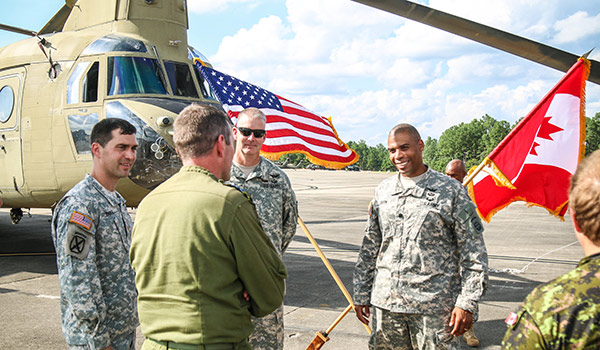
From the Aviation Branch Chief / By MG Michael D. Lundy: We must be ready to “fight tonight with what we’ve got.” That means we must ensure our leaders, Soldiers and equipment are up to the task. Potential adversaries strive to leverage aspects of the operational environment to create ‘niche’ overmatch capabilities against the U.S. military and counter areas of U.S. overmatch. Army Aviation is one of the areas of U.S. overmatch that adversaries are, and will continue to make efforts to counter.

LTC Chris McKenna (2nd from right), commander, 3rd General Support Aviation Battalion, 82nd Combat Aviation Brigade, speaks with Lt. Col. Chris McKenna (2nd from left), commander, 450th Tactical Helicopter Squadron, 1st Wing Kingston, after concluding their pre-deployment site survey (PDSS) on Simmons Airfield, NC, Sept. 9. Army and Canadian Chinook aircrews will conduct a joint training exercise later this year on building the interoperability between both nations. / U.S. ARMY PHOTO BY CPT ADAN CAZAREZ
Survivability is critical to ensuring we remain an asymmetric advantage for the Nation in the current and emerging operational environment. It allows Army Aviation to maintain threat overmatch against an increasingly technologically capable enemy and to enhance the protection of the Aviation force through the continued development of doctrine, leader development, training, and materiel that enable a tactical, operational, and strategic advantage for the Joint Force.
Doctrine
Aviation Survivability Doctrine sets the foundation of how we operate, and standardizes and guides our tactics, techniques and procedures to effectively execute Aviation Operations. FM 3-04, 3-04.2 and 3-04.9 are critical to minimizing risk and enabling aircrews to operate in a threat environment to accomplish the mission. As professional aviators, we need to be experts in this doctrine demonstrating technical and tactical expertise in our field. Leaders must integrate survivability into all phases of planning and execution of the mission to ensure the highest probability of success supporting joint combined arms maneuver.
Tough, performance oriented and realistic training is taking care of Soldiers; and leaders at all levels must fully integrate survivability as part of every training mission and deliberately incorporate it into all training plans leveraging all available resources. As the threat continues to rapidly advance and change, our understanding of threat environment and ability to innovate and execute rigorous, mission essential task list (METL) focused training are even more critical to our readiness and our ability to meet the combatant commander demands.
Key leader development initiatives to “Defrag the Hard Drive” and operationalize our professional military education courses fully integrate survivability into the construct of this training. The goal of defragging the hard drive is to optimize performance to win in the complex world by defragging the non-mission essential information from the human hard drive to make space for the truly mission essential information like survivability. We cannot be intellectually heads down in the cockpit – the complex world is outside and the enemy is studying everything we do. We need to be more diligent than our adversaries and focus on those competencies that enable us to fight and win in all environments and conditions.
Comprehensive Approach
Even as we progress to advanced, integrated aircraft survivability equipment, degraded visual environment, and electronic warfare capabilities on current and future airframes; a comprehensive approach to survivability is critical. These advanced systems will only be effective if employed as a part of a deliberate, holistic approach to survivability. Even the most advanced aircraft survivability equipment employed singularly will ultimately fail. The agile and adaptive aircrew will always be the centerpiece of employing the capability to ensure maximum effect to achieve mission success. It is then that we will fully realize the capabilities of these systems that will allow Army Aviation to fly and fight in all threat and visual environments-under any condition that permits operations by ground forces.
The Army Operating Concept (AOC) envisions a force that as a whole is structured, equipped, trained, and sustained to engage regionally, respond globally, develop situational understanding, establish and maintain security, conduct and sustain high tempo joint combined arms operations, and consolidate gains. The AOC identifies Army Aviation as a “foundational component” that the Army contributes to joint operations. As such, Army Aviation is fundamental to the Army’s contribution to expeditionary maneuver and joint combined arms operations – and, therefore, the AOC. A comprehensive approach to survivability enables Army Aviation to fly and fight in all threat environments which is critical to realizing the AOC, the success of the joint force, and our ability to win our nations wars.
Above the Best!
MG Michael D. Lundy is the Army Aviation branch chief and commander of the U.S. Army Aviation Center of Excellence and Fort Rucker, AL.
























